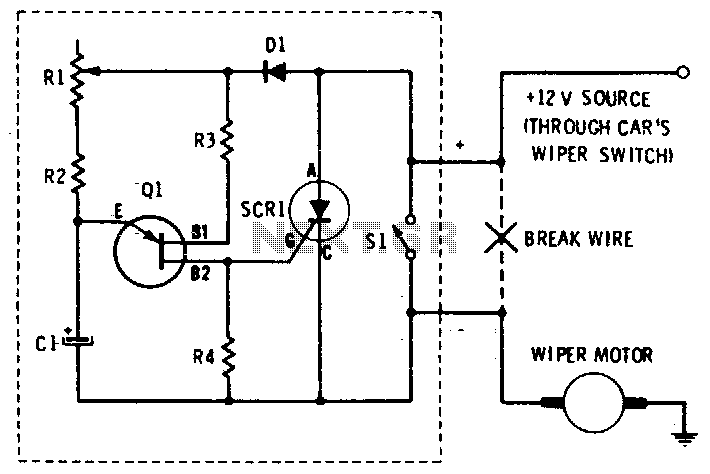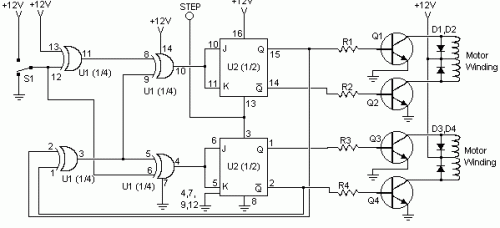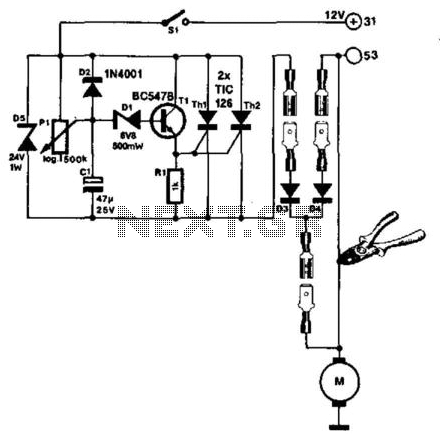
Windshield wiper controller

This circuit provides complete speed control over a car's windshield wipers. The wipers can be slowed down to any rate, even down to four sweeps per minute. The controller consists of two principal circuits: the rate-determining circuit, which is a unijunction transistor configured as a free-running oscillator, and the silicon-controlled rectifier, which serves as the actuator.
The windshield wiper speed control circuit is designed to offer variable speed adjustments, enhancing the driver's ability to manage wiper operation under different weather conditions. The core of the circuit is the unijunction transistor (UJT), which operates as a free-running oscillator. This oscillator generates a pulse-width modulation (PWM) signal that dictates the timing of the wiper motor's operation.
The UJT is characterized by its ability to produce a continuous oscillation, where the frequency of the oscillation can be adjusted by varying the resistance in the timing circuit. This resistance, typically implemented using a potentiometer, allows for fine-tuning of the wiper speed. The output from the UJT is fed into the gate of a silicon-controlled rectifier (SCR), which functions as the actuator in this system. The SCR is a semiconductor device that can control the power delivered to the wiper motor by varying the phase angle of the AC supply voltage.
As the PWM signal from the UJT varies, it triggers the SCR to conduct for different durations, effectively controlling the average power supplied to the wiper motor. This results in a smooth transition between different speeds, allowing the wipers to operate at a minimum of four sweeps per minute up to their maximum speed. The design is robust and reliable, ensuring that the windshield wipers can be adjusted according to the driver's preference and environmental conditions, thereby improving visibility and safety while driving.This circuit provides complete speed control over car"s windshield wipers. They can be slowed down to any rate even down to four sweeps per minute The controller has two principal circuits: The rate-determining circuit—a unijunction transistor connected as a freerunning oscillator, and the silicon-controlled rectifier which is the actuator.
The windshield wiper speed control circuit is designed to offer variable speed adjustments, enhancing the driver's ability to manage wiper operation under different weather conditions. The core of the circuit is the unijunction transistor (UJT), which operates as a free-running oscillator. This oscillator generates a pulse-width modulation (PWM) signal that dictates the timing of the wiper motor's operation.
The UJT is characterized by its ability to produce a continuous oscillation, where the frequency of the oscillation can be adjusted by varying the resistance in the timing circuit. This resistance, typically implemented using a potentiometer, allows for fine-tuning of the wiper speed. The output from the UJT is fed into the gate of a silicon-controlled rectifier (SCR), which functions as the actuator in this system. The SCR is a semiconductor device that can control the power delivered to the wiper motor by varying the phase angle of the AC supply voltage.
As the PWM signal from the UJT varies, it triggers the SCR to conduct for different durations, effectively controlling the average power supplied to the wiper motor. This results in a smooth transition between different speeds, allowing the wipers to operate at a minimum of four sweeps per minute up to their maximum speed. The design is robust and reliable, ensuring that the windshield wipers can be adjusted according to the driver's preference and environmental conditions, thereby improving visibility and safety while driving.This circuit provides complete speed control over car"s windshield wipers. They can be slowed down to any rate even down to four sweeps per minute The controller has two principal circuits: The rate-determining circuit—a unijunction transistor connected as a freerunning oscillator, and the silicon-controlled rectifier which is the actuator.





